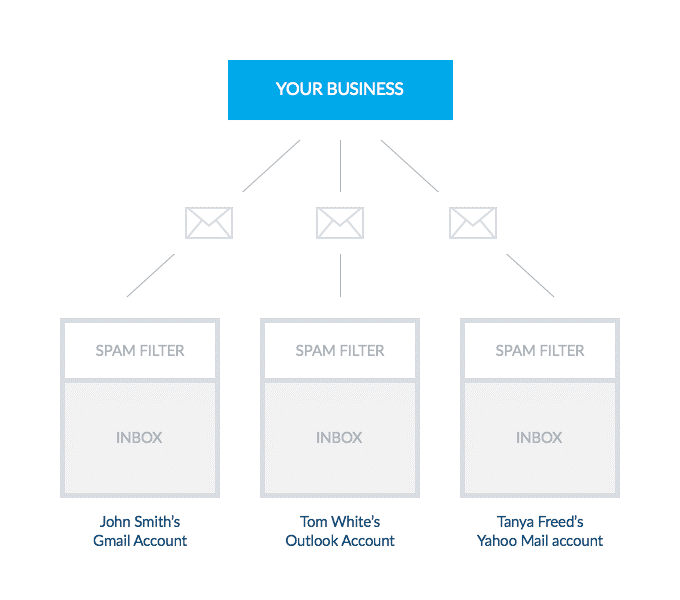When designing email campaigns, the number one consideration should be engagement. For the subscribers on your lists, receiving great content that’s both wanted (they opted in to receive it) and relevant (they’re still interested in receiving it) remains their top concern.
High engagement with your audience—like good open rates, high link clicks, few bounced emails, and low spam complaints—shows inbox providers that you’re a trustworthy sender. Inbox providers (like Gmail and Yahoo) are more likely to place your emails in your user’s inbox, rather than filtering your emails as spam or blocking them outright. Imagine investing time and resources into a campaign that never reaches the target audience, or ends up in the junk or spam folder.
Source: Campaign Monitor
Many different factors can cause your emails to end up in a junk or spam folder. Spam is defined as any irrelevant or unsolicited emails sent to people.
If a subscriber hasn’t given you the appropriate consent to email them, they’re likely to mark your email as spam or even move your emails to the spam folder manually. In this case, keeping that recipient on your list poses a big risk. Many anti-spam legislations require you stop sending emails to people that don’t want your emails, so continuing to send emails to these people could be a breach in violation of those anti-spam laws. Also, the more your emails get flagged as spam, the more you damage your reputation as a good and trusted sender.
Different inbox providers use their own machine learning algorithms to determine which emails are accepted and land in the inbox, and which are rejected or filtered as spam. Email spam tests give you a good indication of how a typical spam filter will review your email’s content, as content is one of many factors an anti-spam algorithm will check.
However, spam tests can’t give you an insight into your sender reputation, which is based on past and present list engagement. The best indicator is to see how your campaigns are performing with different inbox providers.
What are email spam tests?
Different inbox providers use various spam filters to prevent unwanted emails from reaching the recipient’s inbox. Every email passes through a filter to check its content before routing it to the subscriber.
The spam filter checks a variety of items relating to the content of the message to ensure it meets a minimum threshold. If your content doesn’t meet the necessary requirements, the filter will flag the email and route it to the spam folder or block the email altogether. An email spam test carries out an analysis similar to this process, and will tell you if your email passed or failed the test.
Gmail filters 10 million spam and malicious emails from users every minute.
How to measure the success of an email spam test
A spam test will indicate the elements of your copy that a filter will interpret as spam. Every filter is different, using a variety of scores and weightings to assign a spam ranking for the email. If your email exceeds the threshold, you’re likely to end up in the spam folder.
With Campaign Monitor, you can test email for spam with the click of a button. The test will evaluate your content against the following spam filters:
- Symantec Cloud
- Gmail
- Yahoo
- Spam Assassin
- Outlook 2013
Once you have the results, you’ll be able to make changes so your latest email campaigns are less likely to be blocked by spam content filters. It’s important to remember that content is one of many factors influencing inbox placement. It’s possible to pass a spam filter test, but still land in the spam folder if you have a poor sender reputation.
Does it really matter?
Every time you send a communication to one of your subscribers, it influences your sender reputation and the success of your email deliverability. Similarly, if you continue to send content that’s constantly blocked or filtered as spam, your reputation will suffer. Keeping track of how “spammy” your campaign content is (and taking steps to reduce those elements) while monitoring audience engagement will help your emails successful land in the inbox.
A spam filter can evaluates content for issues such as:
- All words written with capital letters
- Spam terminology and a list of spam words
- Any lorem ipsum text
- Subject lines that are too long or too short
- Amount of exclamation points used
- Long and wordy emails
- Image-only emails
It takes a lot of time and effort to build a list of active and engaged subscribers, and it’s important to take steps to maintain a healthy list. Focusing on keeping your most active subscribers engaged, removing inactive subscribers over time, and using spam tests to prevent content blocks will definitely increase inbox placement.
What now?
If your email content does fail a spam test, you can troubleshoot the issue using a test email account with that inbox provider. For example, if the test shows an issue with reaching Yahoo addresses, you can test using a Yahoo email address.
We’d suggest doing some trial-and-error test sending, removing content you think may be tripping the spam filter. If the email lands in your inbox, then there’s a good chance you’ve passed that spam filter. Here’s more information about spam filters that may help you in this process.
Email marketing remains the best ROI option for companies to nurture new leads, convert them into customers, and provide regular updates about products or services.
As modern inbox providers become better at detecting and preventing spam and unwanted emails from reaching their users’ inboxes, marketers need to adjust accordingly. Sending emails to fully opted-in lists, focusing on maintaining an engaged audience, running spam tests to remove problematic content, and regularly removing inactive contacts, is a surefire way of increasing inbox placement and your marketing ROI.
